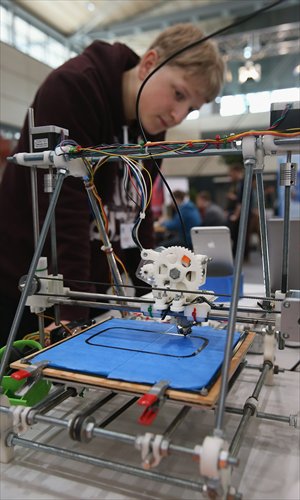HOME >> SCI-TECH
The coming age of 3D
Source:AFP-Global Times Published: 2015-3-20 5:03:02
Rapid tech advances herald sweeping change in industry

A student from a high school in Barsinghausen presents a homemade 3D printer at the 2015 CeBIT technology trade fair on Monday in Hanover, Germany. Photo: CFP
Need a copy of your wedding ring, a new name tag for the dog, or a spare part for the washing machine? Just print it, is the message at the CeBIT IT fair in Germany this week.
A host of companies are showcasing new tech marvels, from Web-connected robots to 3D printers, that can turn homes and offices into design labs and mini factories.
They say the merging of the virtual and physical worlds will unleash a wave of creativity, democratize manufacturing, and lead people to print rather than buy their Christmas presents.
One of the most eye-catching projects at CeBIT in Hanover is "Robochop", where heavy-duty industrial robots carve foam cubes into furniture or sculptures, based on designs people upload online.
Part tech show, part digital-age art installation, it invites Internet users worldwide to create a shape on their PC or tablet using simple design software and upload it for the bots to cut using a hot wire.
The 2,000 most inspiring designs will be mailed free of charge to their creators' homes, anywhere in the world, say the brains behind Robochop, design duo Clemens Weisshaar and Reed Kram.
They say the installation is "a means of translating digits into things".
"These robots are a mini factory that is connected not to the owner of the factory but to everyone else," Weisshaar told AFP.
"That's what's going to completely change over the next years. Software will be written that allows users to take over machinery without having the engineering knowledge that you would normally need if you just bought a robot."
Dentures and spaceships
On a more modest scale the 3D printer has for years been a vital tool for designers, engineers, architects and researchers, who use it to create models and prototypes.
But here too, breakneck advances in precision, resolution, speed and available materials are rapidly changing the industry.
3D printing has made headlines with eye-popping uses, including downloadable designs for handguns, a prosthetic beak for a Costa Rican toucan, and the "printing" of entire homes with a mix of concrete and recycled rubble by a Chinese company.
The technology "has in fact been around for more than 25 years, but it has been covered by patents," said Sara Bonomi, of US 3D printer maker formlabs. "The industry is really developing so much now because these patents are expiring and the technology is becoming accessible for everyone."
Formlabs makes desktop 3D printers that have been used to design everything from jewelry to the model spaceships seen in Hollywood blockbuster Interstellar.
While most 3D printers create models "from the bottom up", using resin from a nozzle to add layer upon layer, formlabs employs lasers that solidify a resin to create objects with ultra-crisp detail, in a process sometimes called "optical fabrication."
Compostable plastic
As 3D printing advances, becomes more affordable and enters more homes, it will change the way people live, Bonomi said.
"In the future we will be able to customize rings and shoes, and then you can just print them at home," she said - cautioning that this may lead some do-it-yourselfers to create counterfeits of branded products.
"There will be more questions about copyright," she warned.
Vitezslav Musilek, of Czech company be3D, predicted that "the world in 10 years will be much easier to live in."
"If you need to purchase a replacement part or you want a new product, you will either download it from a Web page or model it yourself and then print it on your home 3D printer or somewhere else," he said.
Such objects would include "a mobile phone case, household appliances like a missing part in your dishwasher, or maybe your own chess set."
Posted in: Feature